Polarization Characterization of Soft X-Ray Radiation at FERMI FEL-2
Abstract
:1. Introduction
2. Materials and Methods
2.1. FERMI FEL-2
2.2. The Photon Beam Transport
2.3. The Electron Time-Of-Flight Polarimeter
3. Results and Discussion
4. Conclusions
Acknowledgments
Author Contributions
Conflicts of Interest
References
- Eisebitt, S.; Luning, J.; Schlotter, W.F.; Lorgen, M.; Hellwig, O.; Eberhardt, W.; Stohr, J. Lensless imaging of magnetic nanostructures by X-ray spectro-holography. Nature 2004, 432, 885–888. [Google Scholar] [CrossRef] [PubMed]
- Boeglin, C.; Beaurepaire, E.; Halte, V.; Lopez-Flores, V.; Stamm, C.; Pontius, N.; Durr, H.A.; Bigot, J.Y. Distinguishing the ultrafast dynamics of spin and orbital moments in solids. Nature 2010, 465, 458–461. [Google Scholar] [CrossRef] [PubMed]
- Von Korff Schmising, C.; Pfau, B.; Schneider, M.; Günther, C.M.; Giovannella, M.; Perron, J.; Vodungbo, B.; Müller, L.; Capotondi, F.; Pedersoli, E.; et al. Imaging Ultrafast Demagnetization Dynamics after a Spatially Localized Optical Excitation. Phys. Rev. Lett. 2014, 112, 217203. [Google Scholar] [CrossRef]
- Garcia, G.A.; Nahon, L.; Lebech, M.; Houver, J.C.; Dowek, D.; Powis, I. Circular dichroism in the photoelectron angular distribution from randomly oriented enantiomers of camphor. J. Chem. Phys. 2003, 119, 8781–8784. [Google Scholar] [CrossRef]
- Janssen, M.H.M.; Powis, I. Detecting chirality in molecules by imaging photoelectron circular dichroism. Phys. Chem. Chem. Phys. 2014, 16, 856–871. [Google Scholar] [CrossRef] [PubMed]
- Desiderio, D.; Difonzo, S.; Diviacco, B.; Jark, W.; Krempasky, J.; Krempaska, R.; Lama, F.; Luce, M.; Mertins, H.C.; Placentini, M.; et al. The ELETTRA circular polarization beamline and electromagnetic elliptical wiggler insertion device. Synchrotron Radiat. News 1999, 12, 34–38. [Google Scholar] [CrossRef]
- Bahrdt, J.; Frentrup, W.; Gaupp, A.; Scheer, M.; Gudat, W.; Ingold, G.; Sasaki, S. Elliptically polarizing insertion devices at BESSY II. Nucl. Instrum. Methods Phys. Res. Sect. A 2001, 467–468, 21–29. [Google Scholar] [CrossRef]
- Benabderrahmane, C.; Berteaud, P.; Briquez, F.; Couprie, M.E.; Chubar, O.; Dubois, L.; Filhol, J.M.; Girault, M.; Level, M.P.; Marcouillé, O.; et al. First SOLEIL insertion devices are ready to produce photons for users. Nucl. Instrum. Methods Phys. Res. Sect. A 2007, 575, 33–37. [Google Scholar] [CrossRef]
- Nahon, L.; de Oliveira, N.; Garcia, G.A.; Gil, J.F.; Pilette, B.; Marcouillé, O.; Lagarde, B.; Polack, F. DESIRS: A state-of-the-art VUV beamline featuring high resolution and variable polarization for spectroscopy and dichroism at SOLEIL. J. Synchrotron Radiat. 2012, 19, 508–520. [Google Scholar] [CrossRef] [PubMed]
- Wang, H.; Bencok, P.; Steadman, P.; Longhi, E.; Zhu, J.; Wang, Z. Complete polarization analysis of an APPLE II undulator using a soft X-ray polarimeter. J. Synchrotron Radiat. 2012, 19, 944–948. [Google Scholar] [CrossRef] [PubMed]
- Viefhaus, J.; Scholz, F.; Deinert, S.; Glaser, L.; Ilchen, M.; Seltmann, J.; Walter, P.; Siewert, F. The Variable Polarization XUV Beamline P04 at PETRA III: Optics, mechanics and their performance. Nucl. Instrum. Methods Phys. Res. Sect. A 2013, 710, 151–154. [Google Scholar] [CrossRef]
- Vodungbo, B.; Sardinha, A.B.; Gautier, J.; Lambert, G.; Valentin, C.; Lozano, M.; Iaquaniello, G.; Delmotte, F.; Sebban, S.; Lüning, J.; et al. Polarization control of high order harmonics in the EUV photon energy range. Opt. Express 2011, 19, 4346–4356. [Google Scholar] [CrossRef] [PubMed]
- Fleischer, A.; Kfir, O.; Diskin, T.; Sidorenko, P.; Cohen, O. Spin angular momentum and tunable polarization in high-harmonic generation. Nat. Photon. 2014, 8, 543–549. [Google Scholar] [CrossRef]
- Lambert, G.; Vodungbo, B.; Gautier, J.; Mahieu, B.; Malka, V.; Sebban, S.; Zeitoun, P.; Luning, J.; Perron, J.; Andreev, A.; et al. Towards enabling femtosecond helicity-dependent spectroscopy with high-harmonic sources. Nat. Commun. 2015, 6, 6167. [Google Scholar] [CrossRef] [PubMed]
- Pfau, B.; Günther, C.M.; Könnecke, R.; Guehrs, E.; Hellwig, O.; Schlotter, W.F.; Eisebitt, S. Magnetic imaging at linearly polarized X-ray sources. Opt. Express 2010, 18, 13608–13615. [Google Scholar] [CrossRef] [PubMed]
- Wang, T.; Zhu, D.; Wu, B.; Graves, C.; Schaffert, S.; Rander, T.; Müller, L.; Vodungbo, B.; Baumier, C.; Bernstein, D.P.; et al. Femtosecond Single-Shot Imaging of Nanoscale Ferromagnetic Order in Co/Pd Multilayers using resonant X-ray holography. Phys. Rev. Lett. 2012, 108, 267403. [Google Scholar] [CrossRef] [PubMed]
- Kim, K.J. Circular polarization with crossed-planar undulators in high-gain FELs. Nucl. Instrum. Methods Phys. Res. Sect. A 2000, 445, 329–332. [Google Scholar] [CrossRef]
- Deng, H.; Zhang, T.; Feng, L.; Feng, C.; Liu, B.; Wang, X.; Lan, T.; Wang, G.; Zhang, W.; Liu, X.; et al. Polarization switching demonstration using crossed-planar undulators in a seeded free-electron laser. Phys. Rev. Spec. Top. Accel. Beams 2014, 17, 020704. [Google Scholar] [CrossRef]
- Ferrari, E.; Allaria, E.; Buck, J.; De Ninno, G.; Diviacco, B.; Gauthier, D.; Giannessi, L.; Glaser, L.; Huang, Z.; Ilchen, M.; et al. Single Shot Polarization Characterization of XUV FEL Pulses from Crossed Polarized Undulators. Sci. Rep. 2015, 5, 13531. [Google Scholar] [CrossRef] [PubMed]
- Allaria, E.; Appio, R.; Badano, L.; Barletta, W.A.; Bassanese, S.; Biedron, S.G.; Borga, A.; Busetto, E.; Castronovo, D.; Cinquegrana, P.; et al. Highly coherent and stable pulses from the FERMI seeded free-electron laser in the extreme ultraviolet. Nat. Photon. 2012, 6, 699–704. [Google Scholar] [CrossRef]
- Allaria, E.; Castronovo, D.; Cinquegrana, P.; Craievich, P.; Dal Forno, M.; Danailov, M.B.; D’Auria, G.; Demidovich, A.; De Ninno, G.; Di Mitri, S.; et al. Two-stage seeded soft-X-ray free-electron laser. Nat. Photon. 2013, 7, 913–918. [Google Scholar] [CrossRef]
- Sasaki, S. Analyses for a planar variably-polarizing undulator. Nucl. Instrum. Methods Phys. Res. Sect. A 1994, 347, 83–86. [Google Scholar] [CrossRef]
- Temnykh, A.B. Delta undulator for Cornell energy recovery linac. Phys. Rev. Spec. Top. Accel. Beams 2008, 11, 120702. [Google Scholar] [CrossRef]
- Lutman, A.A.; MacArthur, J.P.; Ilchen, M.; Lindahl, A.O.; Buck, J.; Coffee, R.N.; Dakovski, G.L.; Dammann, L.; Ding, Y.; Dürr, H.A.; et al. Polarization control in an X-ray free-electron laser. Nat. Photon. 2016, 10, 468–472. [Google Scholar] [CrossRef]
- Capotondi, F.; Pedersoli, E.; Mahne, N.; Menk, R.H.; Passos, G.; Raimondi, L.; Svetina, C.; Sandrin, G.; Zangrando, M.; Kiskinova, M.; et al. Coherent imaging using seeded free-electron laser pulses with variable polarization: First results and research opportunities. Rev. Sci. Instrum. 2013, 84, 051301. [Google Scholar] [CrossRef] [PubMed]
- Müller, L.; Schleitzer, S.; Gutt, C.; Pfau, B.; Schaffert, S.; Geilhufe, J.; von Korff Schmising, C.; Schneider, M.; Günther, C.M.; Büttner, F.; et al. Ultrafast Dynamics of Magnetic Domain Structures Probed by Coherent Free-Electron Laser Light. Synchrotron Radiat. News 2013, 26, 27–32. [Google Scholar] [CrossRef]
- Mazza, T.; Ilchen, M.; Rafipoor, A.J.; Callegari, C.; Finetti, P.; Plekan, O.; Prince, K.C.; Richter, R.; Danailov, M.B.; Demidovich, A.; et al. Determining the polarization state of an extreme ultraviolet free-electron laser beam using atomic circular dichroism. Nat. Commun. 2014, 5, 3648. [Google Scholar] [CrossRef] [PubMed]
- Allaria, E.; Diviacco, B.; Callegari, C.; Finetti, P.; Mahieu, B.; Viefhaus, J.; Zangrando, M.; De Ninno, G.; Lambert, G.; Ferrari, E.; et al. Control of the Polarization of a Vacuum-Ultraviolet, High-Gain, Free-Electron Laser. Phys. Rev. X 2014, 4, 041040. [Google Scholar] [CrossRef]
- Allaria, E.; Badano, L.; Bassanese, S.; Capotondi, F.; Castronovo, D.; Cinquegrana, P.; Danailov, M.B.; D’Auria, G.; Demidovich, A.; De Monte, R.; et al. The FERMI free-electron lasers. J. Synchrotron Radiat. 2015, 22, 485–491. [Google Scholar] [CrossRef] [PubMed]
- Yu, L.H. Generation of intense uv radiation by subharmonically seeded single-pass free-electron lasers. Phys. Rev. A 1991, 44, 5178–5193. [Google Scholar] [CrossRef] [PubMed]
- Ben-Zvi, I.; Yang, K.; Yu, L. The “fresh-bunch” technique in FELS. Nucl. Instrum. Methods Phys. Res. Sect. A 1992, 318, 726–729. [Google Scholar] [CrossRef]
- Piseri, P.; Dipartimento di Fisica, Università degli Studi di Milano, Milano, Italy. Private communication, 2016.
- Fennel, T.; Institute of Physics, University of Rostock, Rostock, Germany. Private communication, 2016.
- Zangrando, M.; Cocco, D.; Fava, C.; Gerusina, S.; Gobessi, R.; Mahne, N.; Mazzucco, E.; Raimondi, L.; Rumiz, L.; Svetina, C. Recent results of PADReS, the Photon Analysis Delivery and REduction System, from the FERMI FEL commissioning and user operations. J. Synchrotron Radiat. 2015, 22, 565–570. [Google Scholar] [CrossRef] [PubMed]
- Svetina, C.; Cocco, D.; Mahne, N.; Raimondi, L.; Ferrari, E.; Zangrando, M. PRESTO, the on-line photon energy spectrometer at FERMI: Design, features and commissioning results. J. Synchrotron Radiat. 2016, 23, 35–42. [Google Scholar] [CrossRef] [PubMed]
- Svetina, C.; Grazioli, C.; Mahne, N.; Raimondi, L.; Fava, C.; Zangrando, M.; Gerusina, S.; Alagia, M.; Avaldi, L.; Cautero, G.; et al. The Low Density Matter (LDM) beamline at FERMI: Optical layout and first commissioning. J. Synchrotron Radiat. 2015, 22, 538–543. [Google Scholar] [CrossRef] [PubMed]
- Schäfers, F.; Mertins, H.C.; Gaupp, A.; Gudat, W.; Mertin, M.; Packe, I.; Schmolla, F.; Fonzo, S.D.; Soullié, G.; Jark, W.; et al. Soft-X-ray polarimeter with multilayer optics: Complete analysis of the polarization state of light. Appl. Opt. 1999, 38, 4074–4088. [Google Scholar] [CrossRef] [PubMed]
- Wang, H.; Dhesi, S.S.; Maccherozzi, F.; Cavill, S.; Shepherd, E.; Yuan, F.; Deshmukh, R.; Scott, S.; van der Laan, G.; Sawhney, K.J.S. High-precision soft X-ray polarimeter at Diamond Light Source. Rev. Sci. Instrum. 2011, 82, 123301. [Google Scholar] [CrossRef] [PubMed]
- Grizolli, W.; Laksman, J.; Hennies, F.; Jensen, B.N.; Nyholm, R.; Sankari, R. Multilayer based soft-X-ray polarimeter at MAX IV Laboratory. Rev. Sci. Instrum. 2016, 87, 025102. [Google Scholar] [CrossRef] [PubMed]
- Latimer, C.; MacDonald, M.; Finetti, P. A new method for polarization analysis in the VUV. J. Electron Spectrosc. Relat. Phenom. 1999, 101, 875–878. [Google Scholar] [CrossRef]
- Ilchen, M.; Glaser, L.; Scholz, F.; Walter, P.; Deinert, S.; Rothkirch, A.; Seltmann, J.; Viefhaus, J.; Decleva, P.; Langer, B.; et al. Angular Momentum Sensitive Two-Center Interference. Phys. Rev. Lett. 2014, 112, 023001. [Google Scholar] [CrossRef] [PubMed]
- Hartmann, G.; Lindahl, A.O.; Knie, A.; Hartmann, N.; Lutman, A.A.; MacArthur, J.P.; Shevchuk, I.; Buck, J.; Galler, A.; Glownia, J.M.; et al. Circular dichroism measurements at an X-ray free-electron laser with polarization control. Rev. Sci. Instrum. 2016, 87, 083113. [Google Scholar] [CrossRef] [PubMed]
- Codling, K.; Houlgate, R.G.; West, J.B.; Woodruff, P.R. Angular distribution and photoionization measurements on the 2p and 2s electrons in neon. J. Phys. B Atom. Mol. Phys. 1976, 9, L83. [Google Scholar] [CrossRef]
- Yao-Leclerc, I.; Brochet, S.; Chauvet, C.; De Oliveira, N.; Duval, J.P.; Gil, J.F.; Kubsky, S.; Lagarde, B.; Nahon, L.; Nicolas, F.; et al. Handling the carbon contamination issue at SOLEIL. Proc. SPIE 2011, 8077, 807712. [Google Scholar]


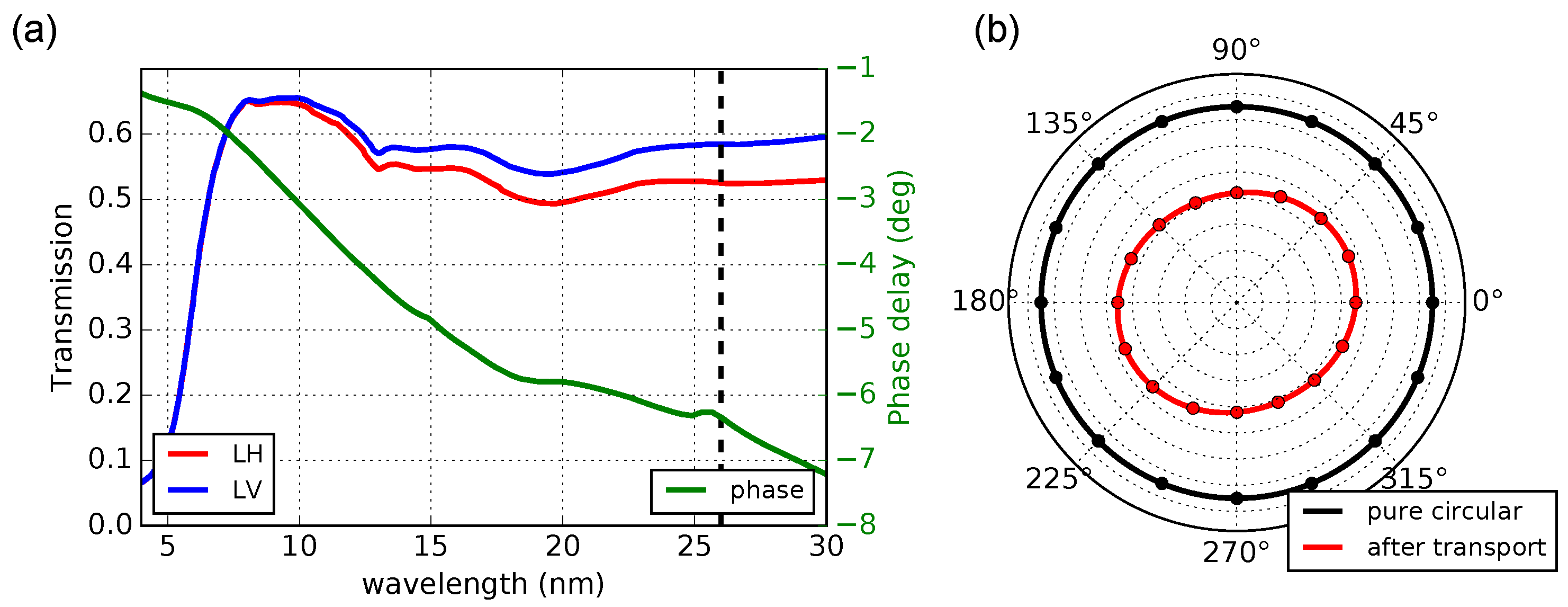
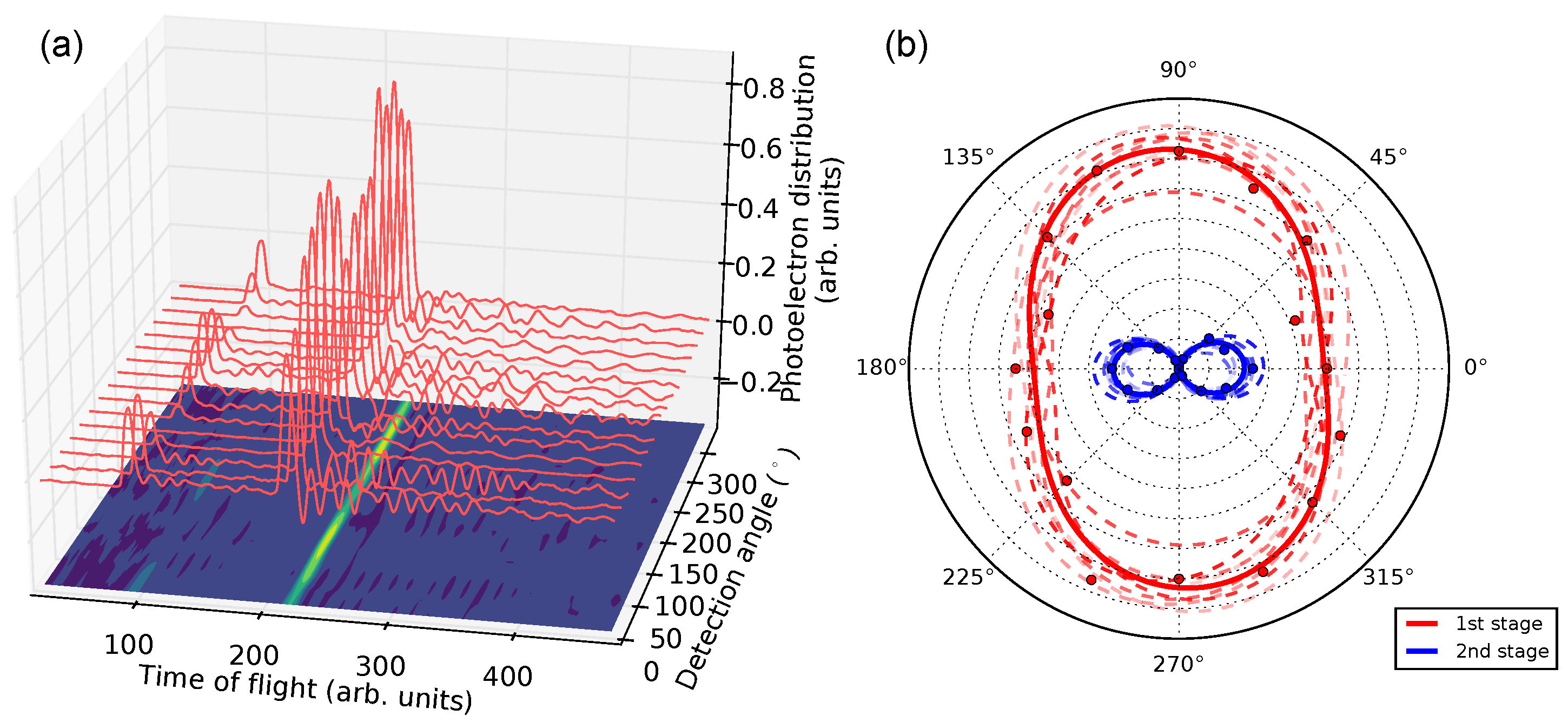
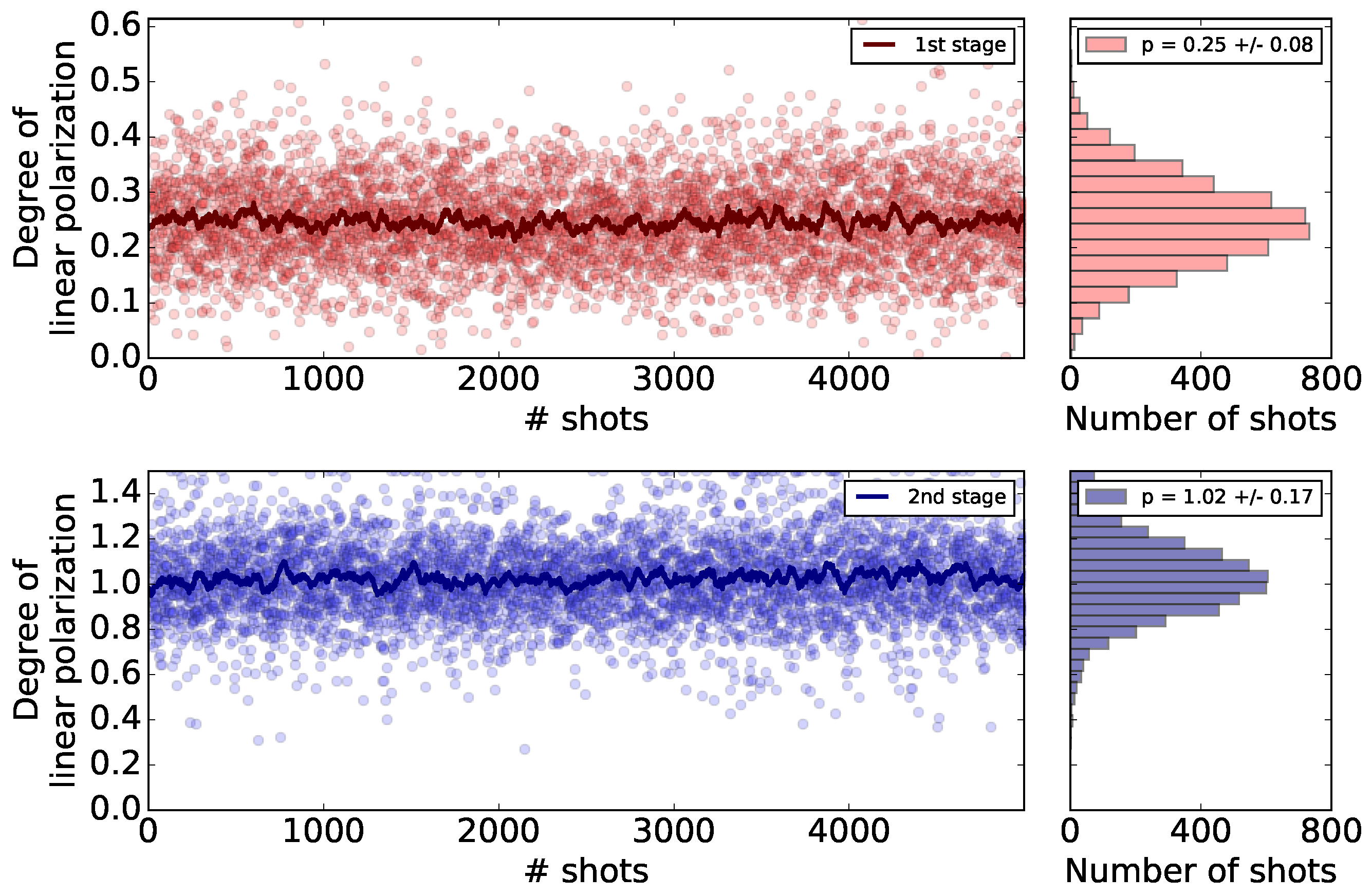
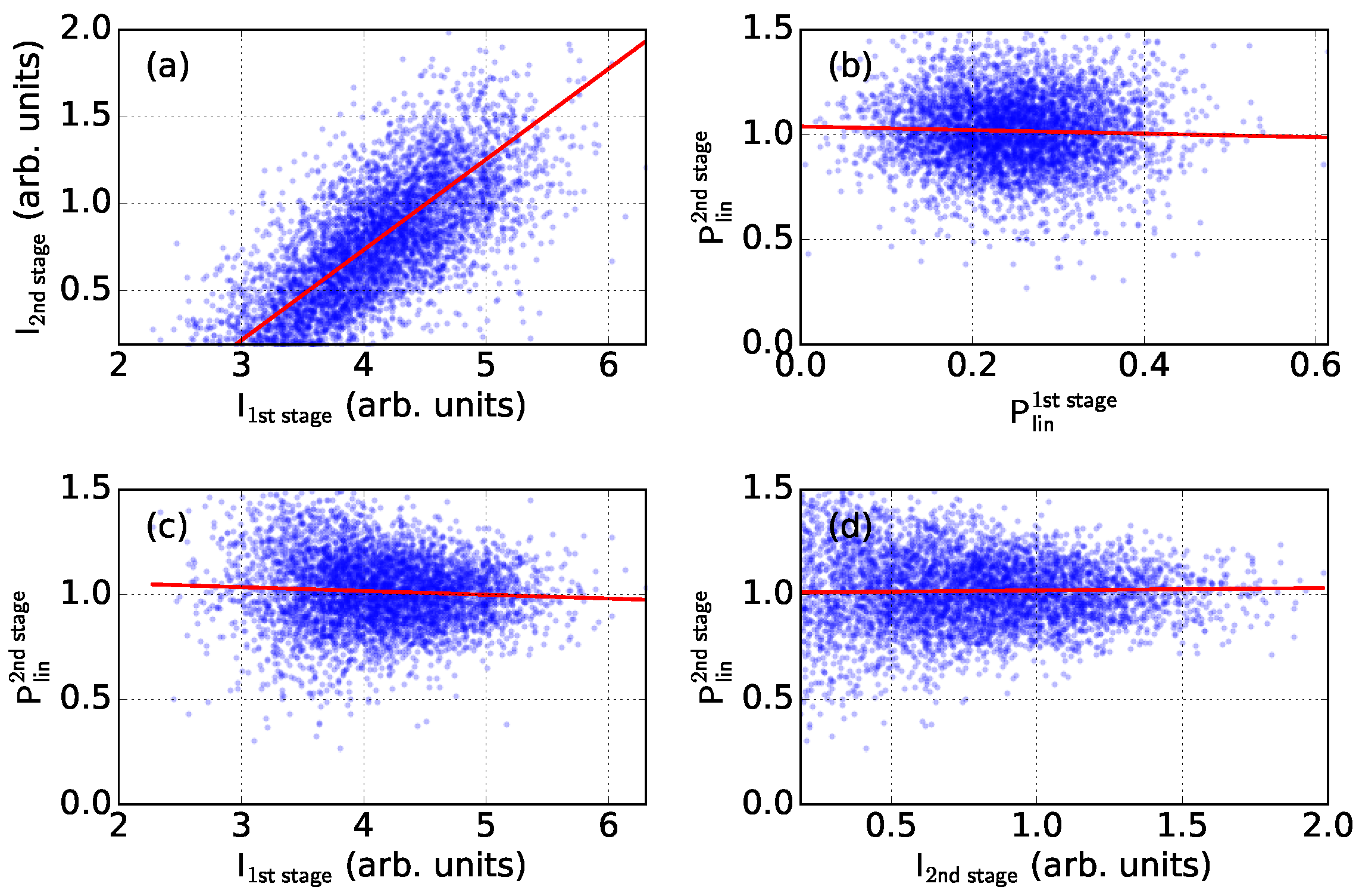
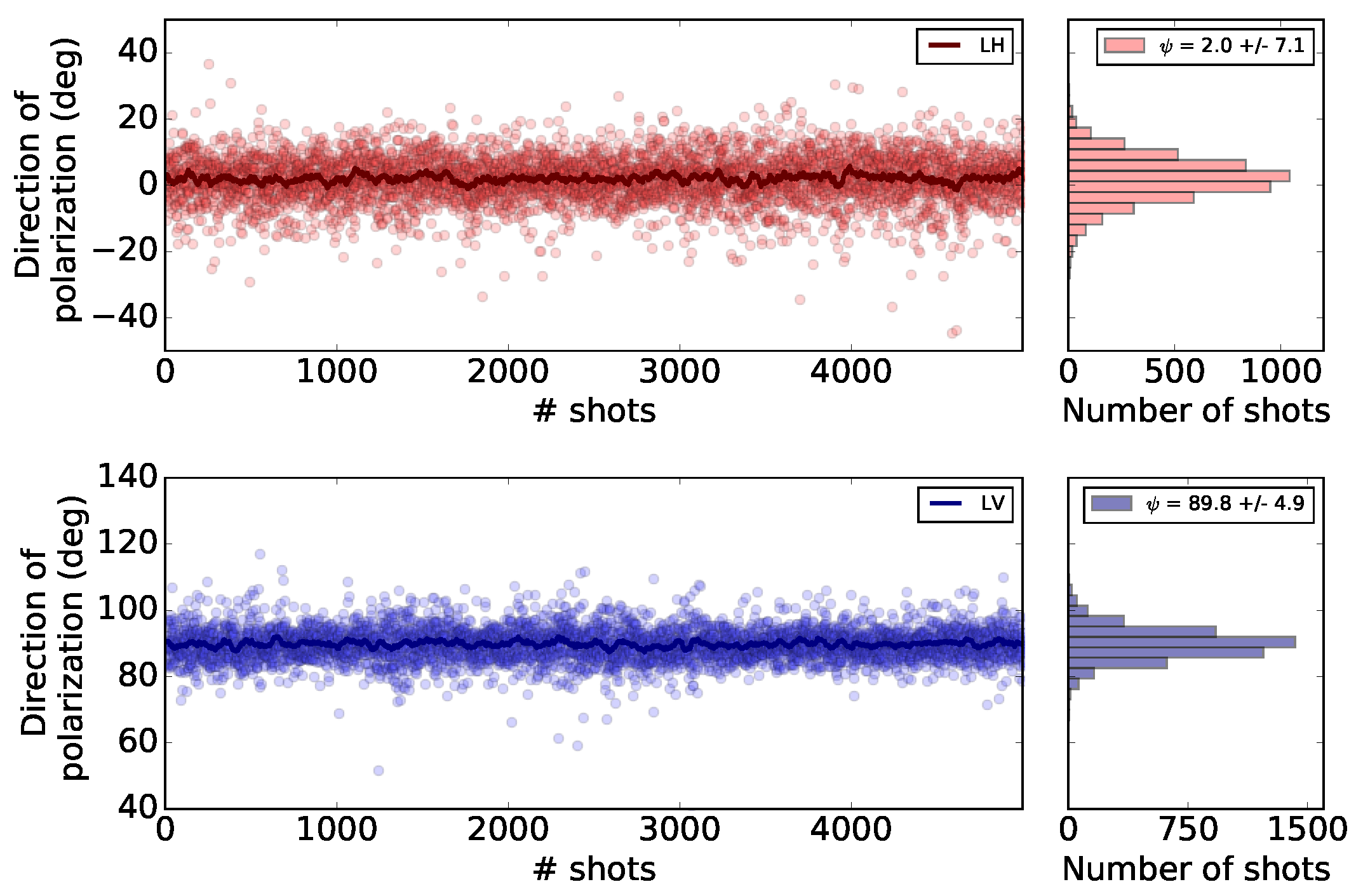
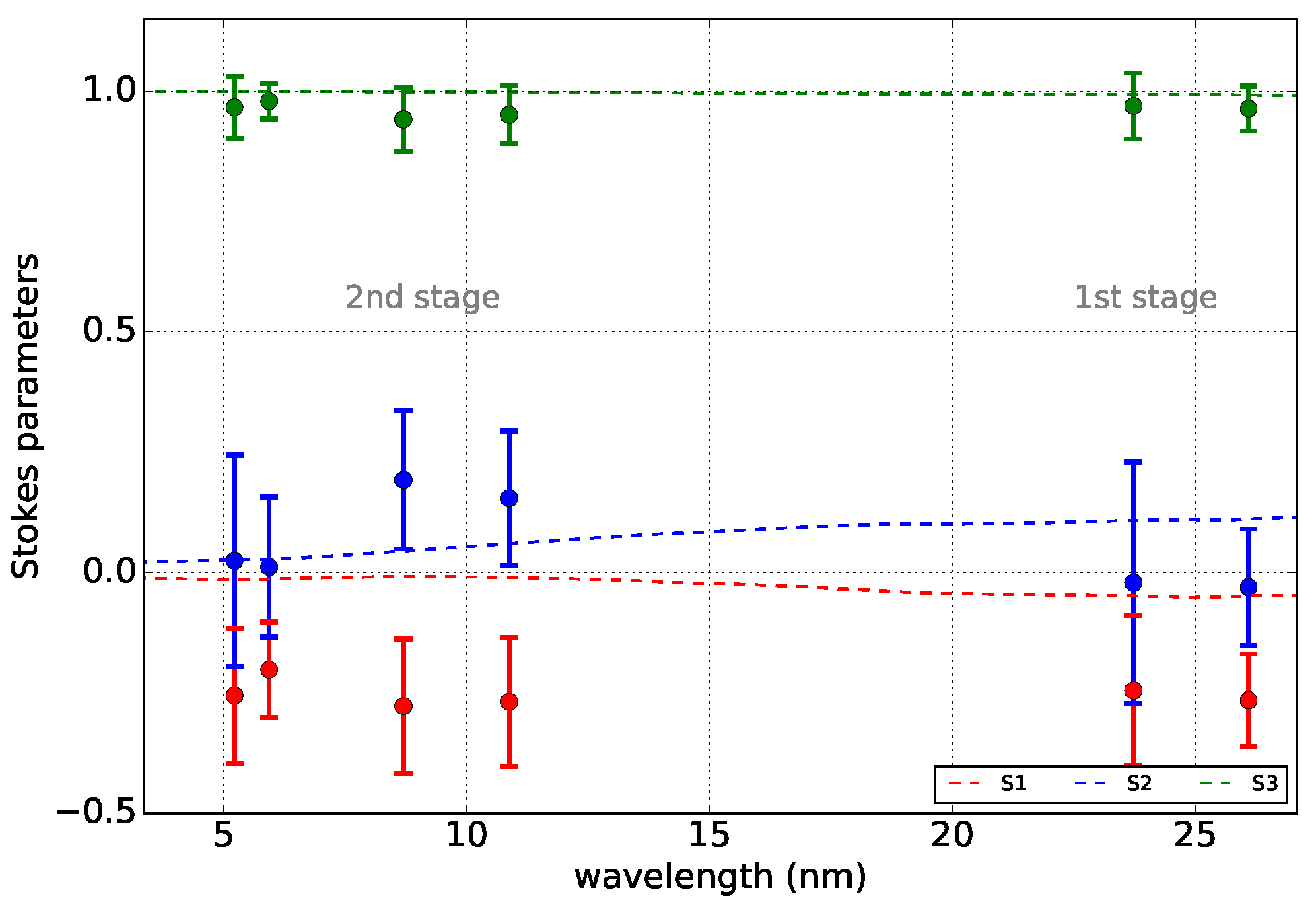
| Parameter | Value | Unit |
|---|---|---|
| Energy | 1.0/1.45 | GeV |
| Slice energy spread (rms) | 150 | keV |
| Slice transverse normalized emittance | ∼1.5 | mm.mrad |
| Peak current | 650 | A |
| Average beam transverse size | 125 | m |
| in the undulator (rms) | ||
| Electron beam magnetic delay line | 260 | fs |
| Repetition rate | 10 | Hz |
| Parameter | Value | Unit |
|---|---|---|
| Wavelength | 261.5 | nm |
| Bandwidth (FWHM) | 1.3 | nm |
| Pulse duration (FWHM) | 135 | fs |
| Available energy per pulse | ≤40 | J |
| Average beam size | 400 | m |
| in the modulator (rms) |
| 1st Stage Modulator | 1st Stage Radiatorsand 2nd Stage Modulator | 2nd Stage Radiators | |
|---|---|---|---|
| Magnetic period (mm) | 100 | 55 | 35 |
| Tuning range (nm) | 300–200 | 114–20 | 18–4 |
| Number of periods | 30 | 42 | 66 |
| Number of segments | 1 | 3 + 1 | 6 |
| Polarization | LH | LH, LV, CR, CL | LH, LV, CR, CL |
| Wavelength (nm) | FEL Polarization | () | ||||
|---|---|---|---|---|---|---|
| Circular right | ||||||
| Circular right | ||||||
| Circular right | ||||||
| Circular right | ||||||
| Circular right | ||||||
| Circular right | ||||||
| Linear horizontal | ||||||
| Linear horizontal | ||||||
| Linear horizontal | ||||||
| Linear vertical | ||||||
| Linear vertical |
© 2017 by the authors. Licensee MDPI, Basel, Switzerland. This article is an open access article distributed under the terms and conditions of the Creative Commons Attribution (CC BY) license (http://creativecommons.org/licenses/by/4.0/).
Share and Cite
Roussel, E.; Allaria, E.; Callegari, C.; Coreno, M.; Cucini, R.; Mitri, S.D.; Diviacco, B.; Ferrari, E.; Finetti, P.; Gauthier, D.; et al. Polarization Characterization of Soft X-Ray Radiation at FERMI FEL-2. Photonics 2017, 4, 29. https://doi.org/10.3390/photonics4020029
Roussel E, Allaria E, Callegari C, Coreno M, Cucini R, Mitri SD, Diviacco B, Ferrari E, Finetti P, Gauthier D, et al. Polarization Characterization of Soft X-Ray Radiation at FERMI FEL-2. Photonics. 2017; 4(2):29. https://doi.org/10.3390/photonics4020029
Chicago/Turabian StyleRoussel, Eléonore, Enrico Allaria, Carlo Callegari, Marcello Coreno, Riccardo Cucini, Simone Di Mitri, Bruno Diviacco, Eugenio Ferrari, Paola Finetti, David Gauthier, and et al. 2017. "Polarization Characterization of Soft X-Ray Radiation at FERMI FEL-2" Photonics 4, no. 2: 29. https://doi.org/10.3390/photonics4020029






